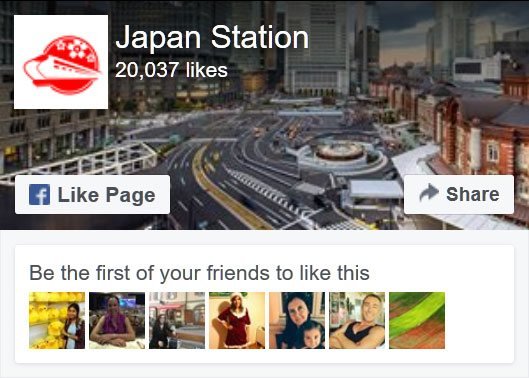The Yokosuka Line is a railway line operated by JR East that runs between Tokyo Station and Kurihama Station in the city of Yokosuka, Kanagawa Prefecture.
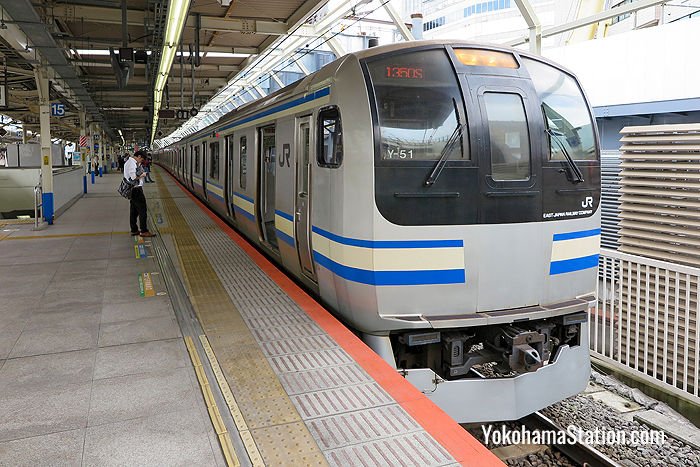
A Yokosuka Line service bound for Chiba at Yokohama Station
At Yokohama Station northbound Yokosuka Line services for Shinagawa and Tokyo depart from Platform 10. Southbound services for Kamakura and Kurihama depart from Platform 9. This line is fully covered by the Japan Rail Pass.
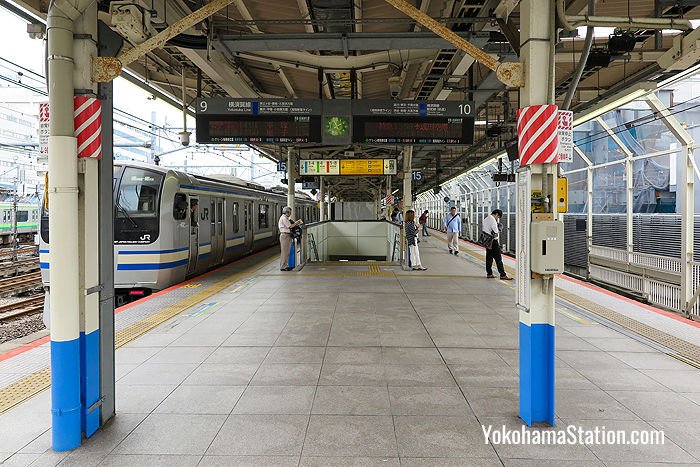
Platforms 9 and 10 at Yokohama Station
Northbound Destinations
There are 7 stations between Yokohama and Tokyo.
Yokohama – Shin-Kawasaki – Musashi-Kosugi – Nishi-Oi – Shinagawa – Shimbashi – Tokyo
Through services on this line go beyond Tokyo Station as far as Chiba Station via the Sobu Line and some services continue on the Narita Line to Narita Airport. The key northbound destinations are listed below with example fares and journey times given from Yokohama.
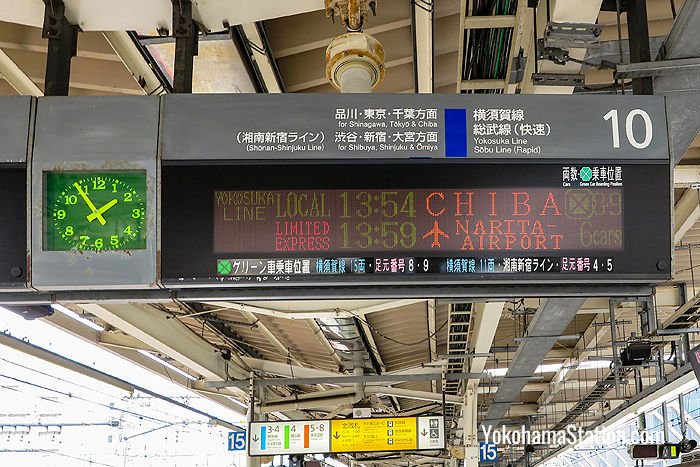
Departure information at Platform 10, Yokohama Station
Shin-Kawasaki Station
This station serves the city of Kawasaki. Though this is mainly an industrial city, it does have several attractions. Kawasaki Daishi Temple is a large Shingon Buddhist temple complex first established in 1128. The temple grounds include several beautiful buildings including an octagonal five-storied pagoda.
Japan Open-Air Folk House Museum (Nihon Minka-en) is an outdoor architectural museum with traditional farm houses, samurai residences, and merchant houses that have been moved here from locations all over Japan. Other sites of interest are the Taro Okamoto Museum of Art, the Toshiba Science Museum, and for manga fans the Fujiko F. Fujio Museum which is dedicated to the creator of Doraemon.
Train fare: 220 yen
Train time: 9 minutes
Musashi-Kosugi Station
Transfers can be made here to the JR Nambu Line, Tokyu Toyoko Line, and Tokyu Meguro Line.
Train fare: 220 yen
Train time: 12 minutes
Shinagawa Station
There are several museums and a temple of historic interest in the area around Shinagawa station. The Hara Museum is an arts museum housed in a Bauhaus building dating from 1938. The Nikon Museum details the history and technology of Nikon cameras and other products and has several rare cameras on display. The Jade Ore Museum displays a private collection of jade stones and artistic objects carved from jade, some of which are on sale. Hatakeyama Memorial Museum of Fine Art exhibits a collection of Japanese, Chinese, and Korean art works related to the tea ceremony. Sengakuji Temple is the location of the graves of the heroic 47 Ronin; a group of samurai who are famous for their loyalty to their master.
Transfers can be made at Shinagawa Station to the JR Yamanote Line and the Tokaido Shinkansen.
Train fare: 300 yen
Train time: 25 minutes
Shimbashi Station
Exit here for the Old Shimbashi Station Railway Museum which exhibits materials related to local railway history. Just outside Shimbashi Station’s Hibiya Exit there is a meeting spot called “SL Square” where an old 1945 steam locomotive is on display.
Transfers can be made here to the JR Yamanote Line, the Toei Asakusa Line, and the New Transit Yurikamome Line.
Train fare: 380 yen
Train time: 29 minutes
Tokyo Station
Attractions around Tokyo Station include the gardens of the Imperial Palace, the collection of 19th century European art in Mitsubishi Ichigokan Museum, and Tokyo Station itself. Exit from the Marunouchi Exit on the station’s west side and you can see the station’s original red brick façade which dates from 1914.
Tokyo Station is a major interchange with both regular railway and shinkansen services. Transfer here to JR East’s Yamanote Line, Chuo Main Line, Sobu Main Line, Ueno-Tokyo Line, Keiyo Line, and Keihin-Tohoku Line. Transfers can also be made to the following bullet train services: the Tokaido Shinkansen, the Tohoku Shinkansen, the Joetsu Shinkansen, the Yamagata Shinkansen, the Akita Shinkansen, the Hokuriku Shinkansen, and the Hokkaido Shinkansen. Transfers can also be made here to the Tokyo Metro Marunouchi Line. Highway bus terminals are located outside the Yaesu Exit on the east side of the station.
Train fare: 280 yen
Train time: 32 minutes
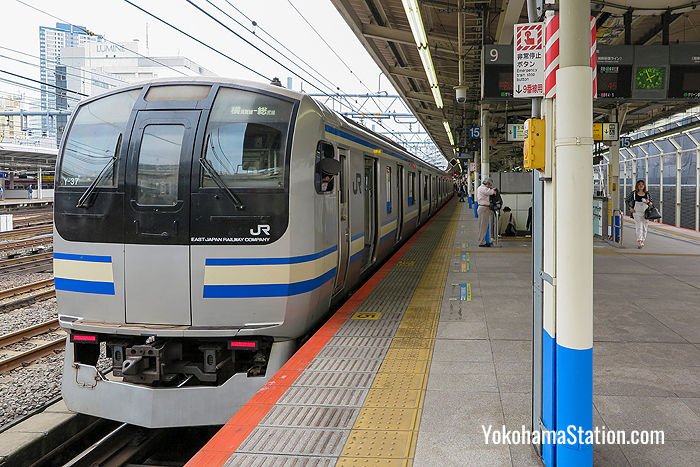
A southbound train for Zushi at Platform 9, Yokohama Station
Southbound Destinations
There are 13 stations between Yokohama and Kurihama.
Yokohama – Hodogaya – Higashi-Totsuka – Totsuka – Ofuna – Kita-Kamakura – Kamakura – Zushi – Higashi-Zushi – Taura – Yokosuka – Kinugasa – Kurihama
The key southbound destinations are listed below with example fares and journey times given from Yokohama.
Ofuna Station
Ofuna Station is located in the city of Kamakura. Exit here for Ofuna Kannon Temple: a 25 meter high statue of Kannon, the goddess of mercy, which is a 5 minute walk from the station. Josenji Temple and the Taya Caves are a 14 minute bus ride from Ofuna Station. The monks of Josenji dug the meditation caves into a limestone hill and decorated their interiors with Buddhist carvings.
Transfers can be made here to the JR Negishi Line, the JR Shonan-Shinjuku Line and the Shonan Monorail.
Train fare: 310 yen
Train time: 18 minutes
Kita-Kamakura Station
Kita-Kamakura Station serves the northern part of Kamakura City. There are several historic and very beautiful Buddhist temples in this area. Engakuji is a major Zen Buddhist temple founded in 1282. Among the structures in this large temple complex, the Shariden (or hall of relics) and the Ogane (or great bell) are both designated National Treasures. Kenchoji Temple was founded in 1253 and is the oldest Zen training monastery in Japan. Tokeiji Temple was founded in 1285 and was formerly a sanctuary for abused wives. Jochiji is a small, peaceful temple with a pretty garden that was founded in 1283. Meigetsuin is a Zen temple founded in 1160 which is famous for its large hydrangea garden.
Train fare: 310 yen
Train time: 21 minutes
Kamakura Station
Kamakura is a seaside town with many historic temples and shrines and is one of Japan’s major sightseeing destinations. The most famous attraction in Kamakura is the Daibutsu (or Great Buddha) statue at Kotokuin Temple. The massive bronze statue dates from 1252 and is over 11 meters tall. Hasedera Temple is best known for its huge wooden statue of Kannon, the goddess of mercy, and is also the site of the Benten-kutsu cave where a statue of the river goddess Benten is enshrined. Zuisenji Temple is popular for its beautiful stroll garden and its Zen rock garden. Hokokuji Temple is famous for its bamboo grove and teahouse. Sugimotodera is an atmospheric temple founded in 734 and is the oldest temple in Kamakura. Tsurugaoka Hachimangu is a huge shrine dedicated to the god of war which was founded in 1063. Kamakura Museum of National Treasures is located on the grounds of Tsurugaoka Hachimangu and exhibits an impressive collection of Buddhist sculptures. The sandy beaches of Kamakura are also popular in the summer months.
Tranfers can be made at Kamakura to the Enoshima Electric Railway (also called the Enoden). The retro carriages of this railway run along a scenic route between Kamakura and the beach resorts of Fujisawa.
Train fare: 350 yen
Train time: 24 minutes
Zushi Station
Zushi is a small beach resort town which is lively in the summer months. Jinmuji is a picturesque temple founded here in 724.
Transfers can be made at nearby Shin-Zushi Station to the Keikyu Zushi Line.
Train fare: 350 yen
Train time: 30 minutes
Yokosuka Station
Yokosuka is a major port city with both American and Japanese naval bases. Here you can take a 45 minute Naval Port Cruise and view both the scenic landscape and various warships that are in dock. The Mikasa is a 19th century battleship that saw action in the Russo-Japanese War (1904-5) and is now open as a museum ship. Sarushima Island with its historic military remains is a 10 minute ferry ride from Yokosuka and is a popular location for camping, fishing, and swimming.
Train fare: 570 yen
Train time: 44 minutes
Kurihama Station
Kurihama is best known for Kurihama Flower Park: a large park which overlooks the sea and is popular for its seasonal flower displays. Perry Memorial Hall has exhibits related to the arrival of the American Admiral Perry and his black ships in 1853. Admiral Perry’s ships first anchored at nearby Uraga before landing at Kurihama, an action which eventually forced Japan to open up to the world after over 200 years of seclusion.
Train fare: 730 yen
Train time: 54 minutes
Useful Links
To plan your journey via the Yokosuka Line use English language route finders like the Japan Transit Planner or Hyperdia. JR East has a PDF route map of their railway network in which both the Yokosuka Line and Sobu Line are numbered 2 and colored dark blue.
Article and original photos by Michael Lambe. All rights reserved.
